Historical Assessments of Inorganic Pollutants in the Sinkhole Region of Winkler County, Texas, USA
Abstract
:1. Introduction
2. Study Area
3. Data and Methods
4. Results and Discussion
4.1. Copper
4.2. Lead
4.3. Arsenic
4.4. Nitrate
4.5. Chromium
4.6. Chloride
4.7. Site Characterization
5. Conclusions
Author Contributions
Funding
Institutional Review Board Statement
Informed Consent Statement
Data Availability Statement
Conflicts of Interest
References
- Hamer, A. 70% of Earth’s Freshwater Is Frozen. Available online: https://www.discovery.com/nature/Earths-Fresh-Water-Frozen (accessed on 1 August 2019).
- United States Environmental Protection Agency (US EPA). National Primary Drinking Water Regulations. 2017. Available online: https://www.epa.gov/ground-water-and-drinking-water/national-primary-drinking-water-regulations (accessed on 9 March 2019).
- United States Geological Survey (USGS). Geology and Ground Water Resources of Winkler County, Texas. Texas Water Science Center. 1993. Available online: https://pubs.er.usgs.gov/publication/wsp1582 (accessed on 1 January 2021).
- Garret, G.; Edwards, R. Aquifers of West Texas. Texas Water Development Board (TWDB). 2001. Available online: https://www.twdb.texas.gov/publications/reports/numbered_reports/doc/R356/356_AquifersofWestTexas.pdf (accessed on 10 March 2020).
- Heo, J.; Yu, J.; Giardino, J.R.; Cho, H. Water resources response to climate and land-cover changes in a semi-arid watershed, New Mexico, USA. Terr. Atmos. Ocean. Sci. 2015, 26, 463–474. [Google Scholar] [CrossRef] [Green Version]
- Johnson, K.S. Development of the Wink Sink in West Texas, U.S.A., Due to Salt Dissolution and Collapse. Environ. Geol. Water Sci. 1989, 14, 81–92. [Google Scholar] [CrossRef]
- Seckler, D.; Barker, R.; Amarasingh, U. Water Scarcity in the Twenty-First Century. Water Resour. Dev. 1999, 15, 29–42. [Google Scholar] [CrossRef]
- Blandford, T.N.; Blazer, D.J. Hydrologic Relationships and Numerical Simulations of the Exchange of Water between the Southern Ogallala and Edwards-Trinity Aquifers in Southwest Texas. 2019. Available online: https://www.twdb.texas.gov/publications/reports/numbered_reports/doc/R360/Ch05.pdf (accessed on 21 March 2020).
- World Health Organization (WHO). Guidelines for Drinking-Water Quality, 4th ed.; Incorporating the first addendum; World Health Organization: Geneva, Switzerland, 2017; pp. 1–564. Available online: https://www.who.int/publications/i/item/9789241549950 (accessed on 1 March 2021).
- National Research Council (NRC). Copper in Drinking Water. 2000. Available online: https://www.nap.edu/catalog/9782/copper-in-drinking-water (accessed on 11 May 2020).
- Alarcon, S. Consumer Confidence Report for Public Water System, city of Kermit. Center for Disease Control and Prevention (CDC). 2017. Available online: https://www.cdc.gov/healthywater/drinking/public/understanding_ccr.html (accessed on 13 December 2020).
- Rodriguez, J.; Heo, J.; Park, J.; Lee, S.S.; Miranda, K. Inorganic Pollutants in the Water of Midland and Odessa, Permian Basin, West Texas. Air Soil Water Res. 2019, 12, 1–7. [Google Scholar] [CrossRef]
- Sharpe, W.; Amy, G. Lead in Drinking Water. Pennsylvania State University Extension. 2020. Available online: https://extension.psu.edu/lead-in-drinking-water (accessed on 21 February 2021).
- Nickson, R.T.; McArthur, J.M.; Shrestha, B.; Kyaw-Myint, T.; Lowry, D. Arsenic and Other Drinking Water Quality Issues, Muzaffargarh District, Pakistan. Appl. Geochem. 2005, 20, 55–68. [Google Scholar] [CrossRef]
- Hudak, P.F. Nitrate, arsenic and selenium concentrations in the Pecos Valley Aquifer, West Texas, USA. Int. J. Environ. Res. 2010, 4, 229–236. [Google Scholar]
- United States Environmental Protection Agency (US EPA). Parameters of Water Quality—Interpretation and Standards Wellhead Protection; EPA: Washington, DC, USA, 2001. [Google Scholar]
- Honeycutt, M.E. Hexavalent chromium in Texas drinking water. Toxicol. Sci. 2011, 119, 423–424. [Google Scholar] [CrossRef] [Green Version]
- Reedy, R.; Scanlon, B.; Walden, S.; Strassberg, G. Naturally Occurring Groundwater Contamination in Texas Final Contract Report Prepared for the Texas Water Development Board. Available online: http://www.twdb.texas.gov/publications/reports/contracted_reports/doc/1004831125.pdf (accessed on 3 December 2020).
- Manz, L.R.; Sarkar, D.; Hammond, W.W., Jr. Water resources and water quality in the Rio Grande Valley of Texas: Current status and future projections. Environ. Geosci. 2005, 12, 193–206. [Google Scholar] [CrossRef]
- Reeves, C.C., Jr.; Miller, W.D. Nitrate, Chloride and Dissolved Solids, Ogallala Aquifer, West Texas. Groundwater 1978, 16, 167–173. [Google Scholar] [CrossRef]
- Shi, Y.; Tang, Y.; Lu, Z.; Kim, J.W.; Peng, J. Subsidence of sinkholes in wink, Texas from 2007 to 2011 detected by time-series InSAR analysis. Geomat. Nat. Hazards Risk 2019, 10, 1125–1138. [Google Scholar] [CrossRef]
- Rodriguez, J.; Heo, J.; Kim, K.H. The Impact of Hydraulic Fracturing on Groundwater Quality in the Permian Basin, West Texas, USA. Water 2019, 12, 796. [Google Scholar] [CrossRef] [Green Version]
- Nelson, R.; Heo, J. Monitoring environmental parameters with oil and gas developments in the Permian Basin, USA. Int. J. Environ. Res. Public Health 2020, 17, 4026. [Google Scholar] [CrossRef] [PubMed]
- Meng, Q. The impact of fracking on the environment: A total environmental study paradigm. Sci. Total Environ. 2017, 580, 953–957. [Google Scholar] [CrossRef] [PubMed]
- Land, L. Geophysical Records of Anthropogenic Sinkhole Formation in the Delaware Basin Region, Southeast New Mexico and West Texas, USA. Carbonates Evaporties 2013, 28, 183–190. [Google Scholar] [CrossRef]
- English, S.; Heo, J.; Won, J. Investigation of Sinkhole Formation with Human Influence: A Case Study from Wink Sink in Winkler County, Texas. Sustainability 2020, 12, 3537. [Google Scholar] [CrossRef]
- Kimmel, T.M., Jr.; Nielsen-Gammon, J.; Rose, B.; Mogil, H.M. The weather and climate of Texas: A big state with big extremes. Weatherwise 2016, 69, 25–33. [Google Scholar] [CrossRef]
- Baumgardner, R.W., Jr.; Hoadley, A.D.; Goldstein, A.G. Formation of the Wink Sink, a salt dissolution and collapse feature, Winkler County, Texas. Virtual Landsc. Tex. 1982, 114, 1–38. [Google Scholar]
- Ackers, A.L.; Dechicchis, R.; Smith, R.H. Hendrick Field, Winkler County, Texas. AAPG Bull. 1930, 14, 923–944. [Google Scholar]
- Janks, J.S.; Yusas, M.R.; Hall, C.M. Clay Mineralogy of an Interbedded Sandstone, Dolomite, and Anhydrite: The Permian Yates Formation, Winkler County, Texas. The Society for Sedimentary Geology (SEPM). 1992. Available online: https://pubs.geoscienceworld.org/books/book/1098/chapter/10549911/Clay-Mineralogy-of-an-Interbedded-Sandstone (accessed on 5 March 2021).
- Apergis, N.; Ewing, B.T.; Payne, J.E. A time series analysis of oil production, rig count and crude oil price: Evidence from six U.S. oil producing regions. Energy 2016, 97, 339–349. [Google Scholar] [CrossRef]
- Ahlfeld, D.P.; Pinder, G.F. Solving stochastic groundwater problems using sensitivity theory and hermite interpolating polynomials. Dev. Water Sci. 1988, 35, 179–184. [Google Scholar]
- Sharma, S.; Bhattacharya, A. Drinking water contamination and treatment techniques. Appl. Water Sci. 2017, 7, 1043–1067. [Google Scholar] [CrossRef] [Green Version]
- Buckley, G. Nitrogen Cycle. Biology Dictionary. Available online: Biologydictionary.net (accessed on 16 May 2020).
- Collins, B.J.; Stout, M.D.; Levine, K.E.; Kissling, G.E.; Melnick, R.L.; Fennell, T.R.; Walden, R.; Abdo, K.; Pritchard, J.B.; Fernando, R.A.; et al. Exposure to hexavalent chromium resulted in significantly higher tissue chromium burden compared with trivalent chromium following similar oral doses to male F344/N rats and female B6C3F1 mice. Toxicol. Sci. 2010, 118, 368–379. [Google Scholar] [CrossRef] [PubMed] [Green Version]
- Swigart, J.; Heo, J.; Wolf, D. Soil contamination assessments from drilling fluids and produced water using combined field and laboratory investigations: A case study of Arkansas, USA. Int. J. Environ. Res. Public Health 2021, 18, 2421. [Google Scholar] [CrossRef]
- Anaya, R.; Jones, I. Groundwater Availability Model for the Edwards-Trinity (Plateau) and Pecos Valley Aquifers of Texas. Texas Water Development Board (TWDB). Report 373; 2009. Available online: https://www.twdb.texas.gov/groundwater/models/alt/eddt_p_2011/ETP_PV_One_Layer_Model.pdf (accessed on 18 November 2020).
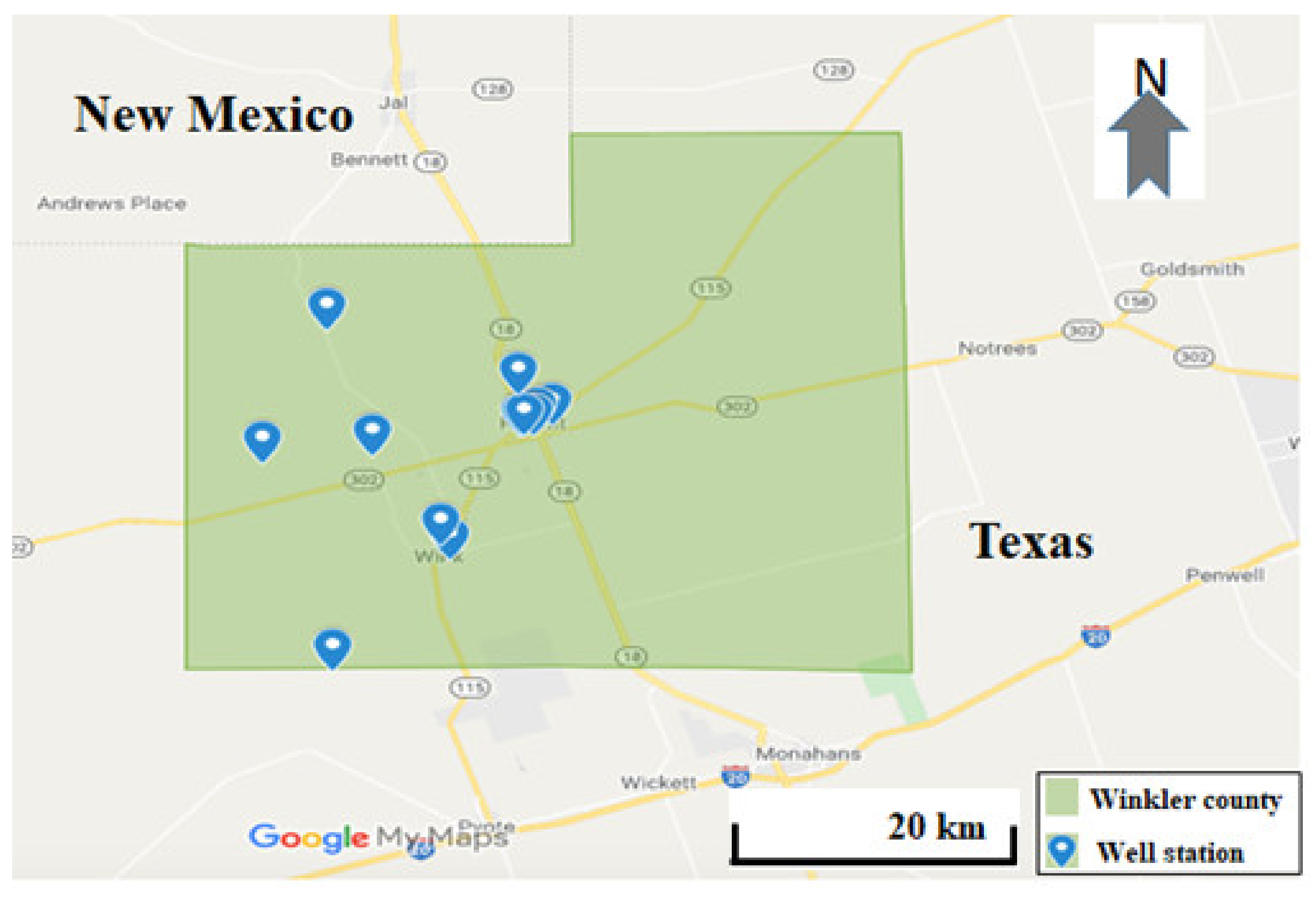

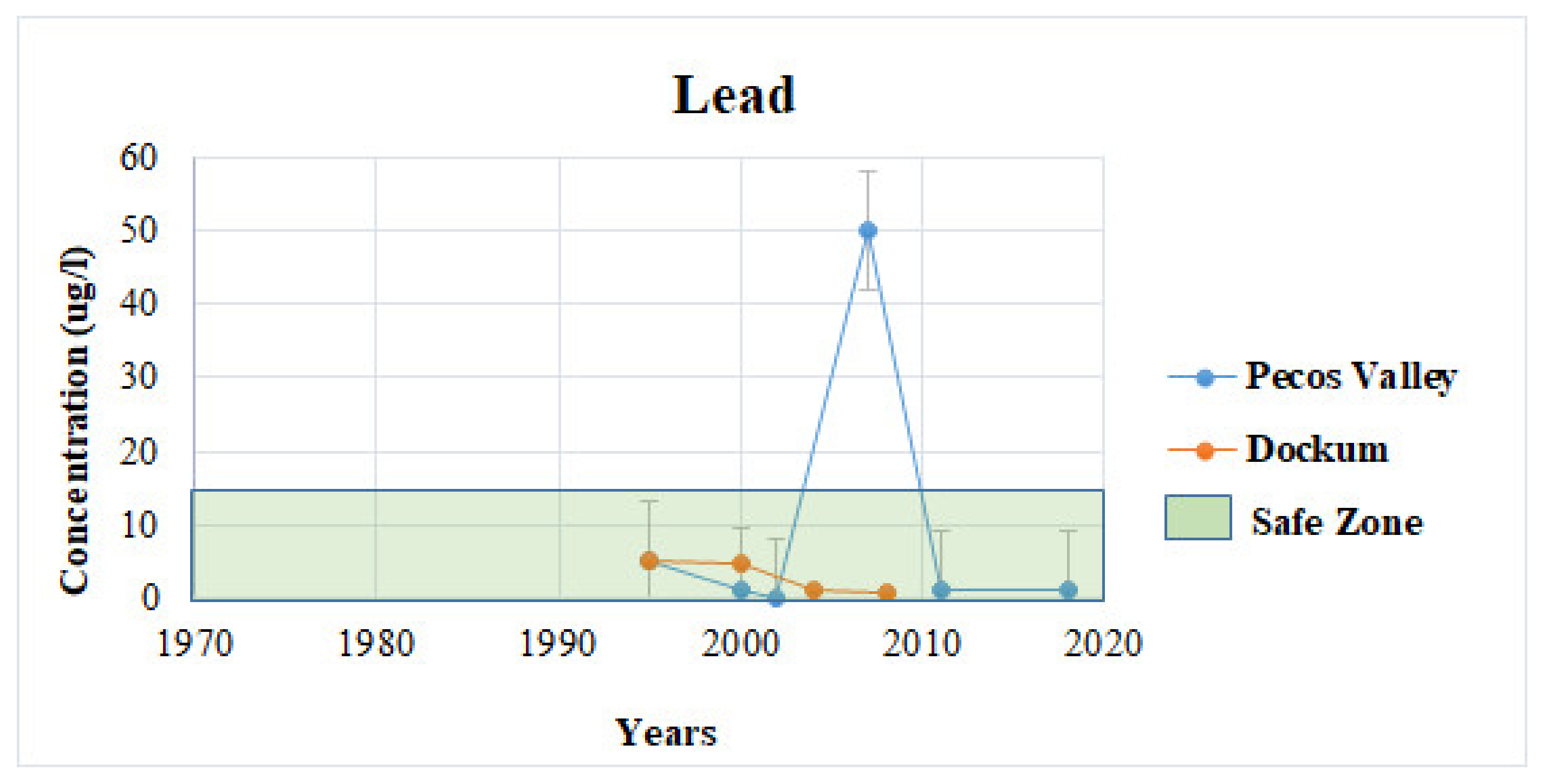



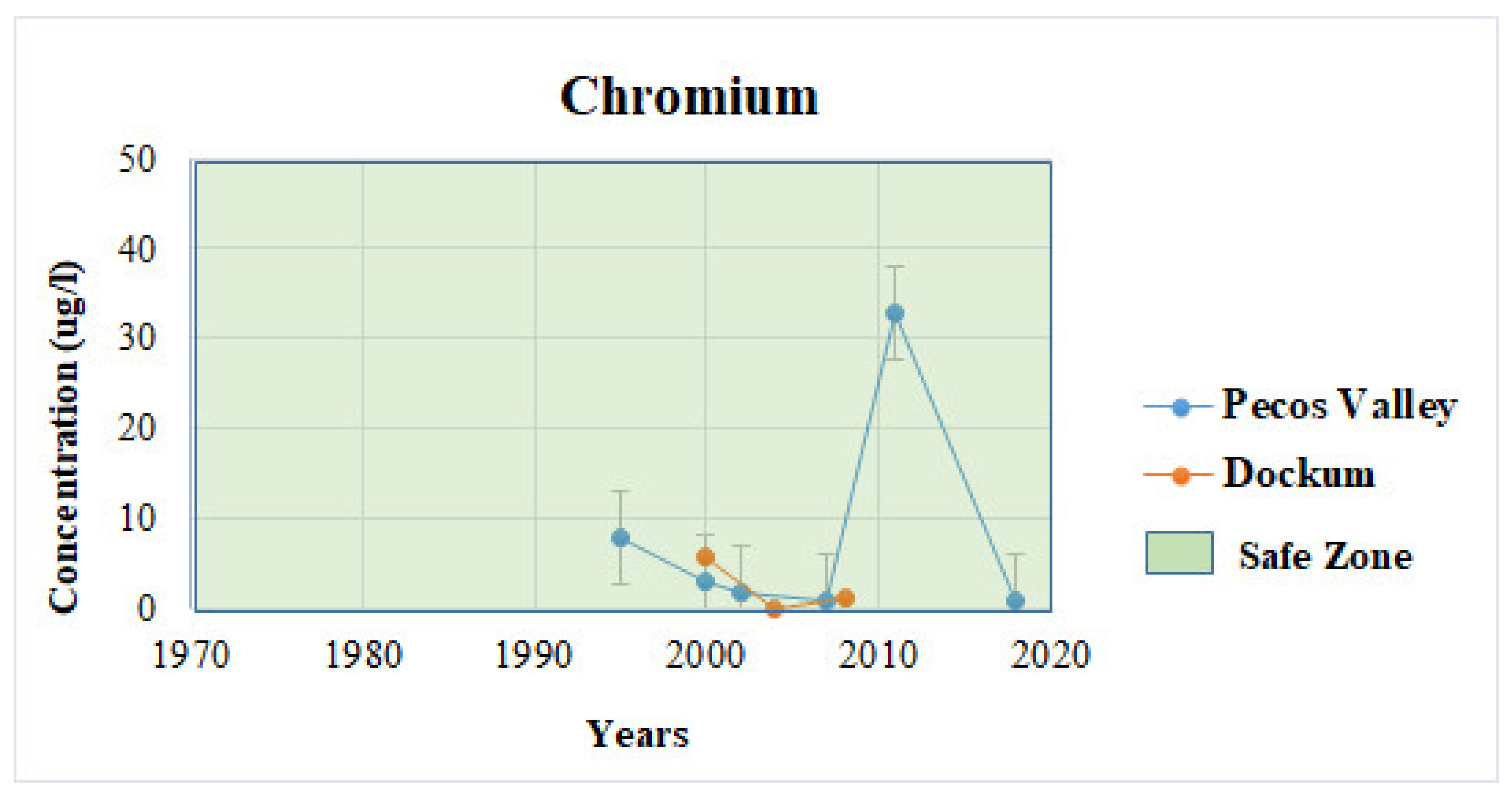
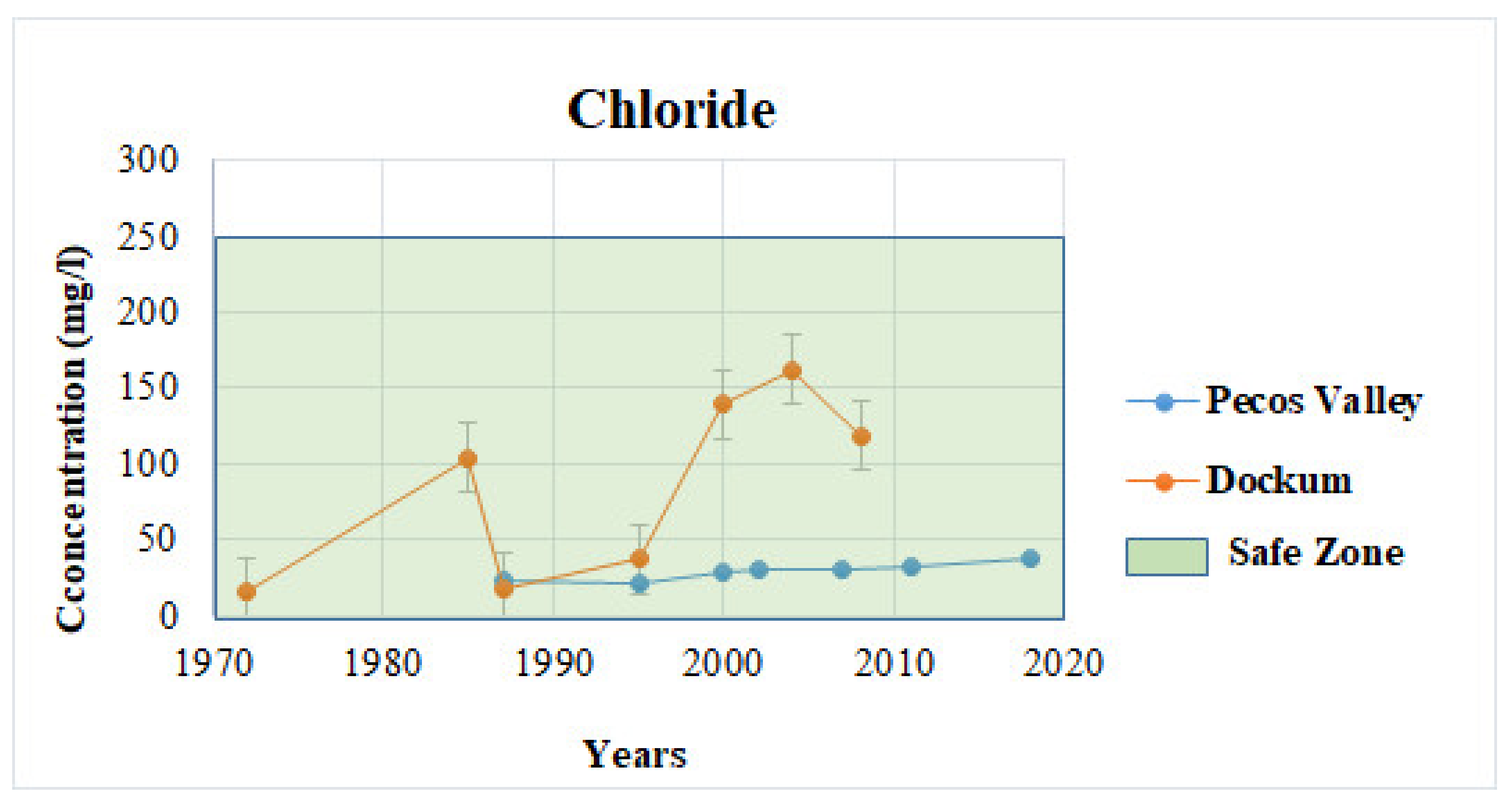
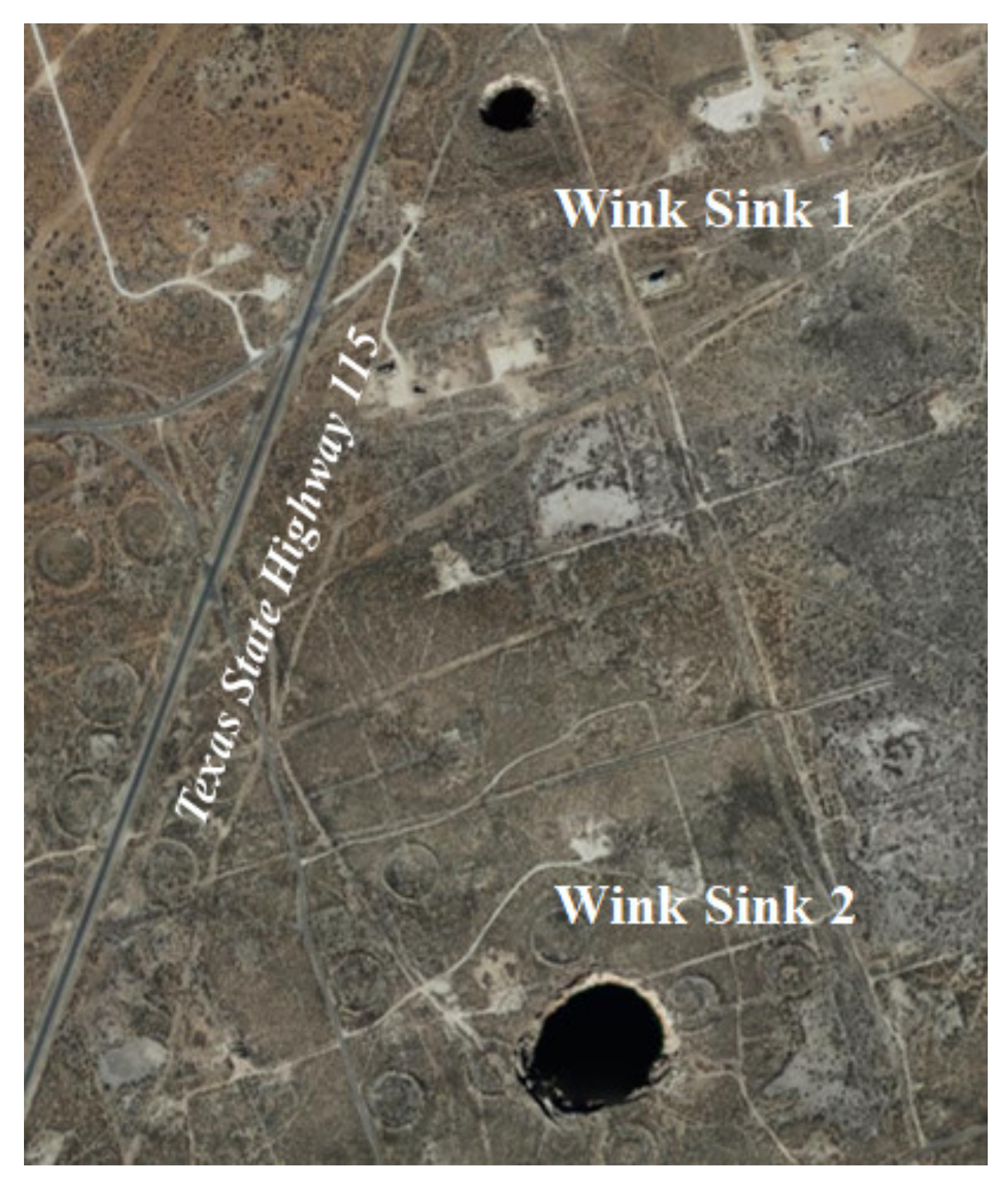

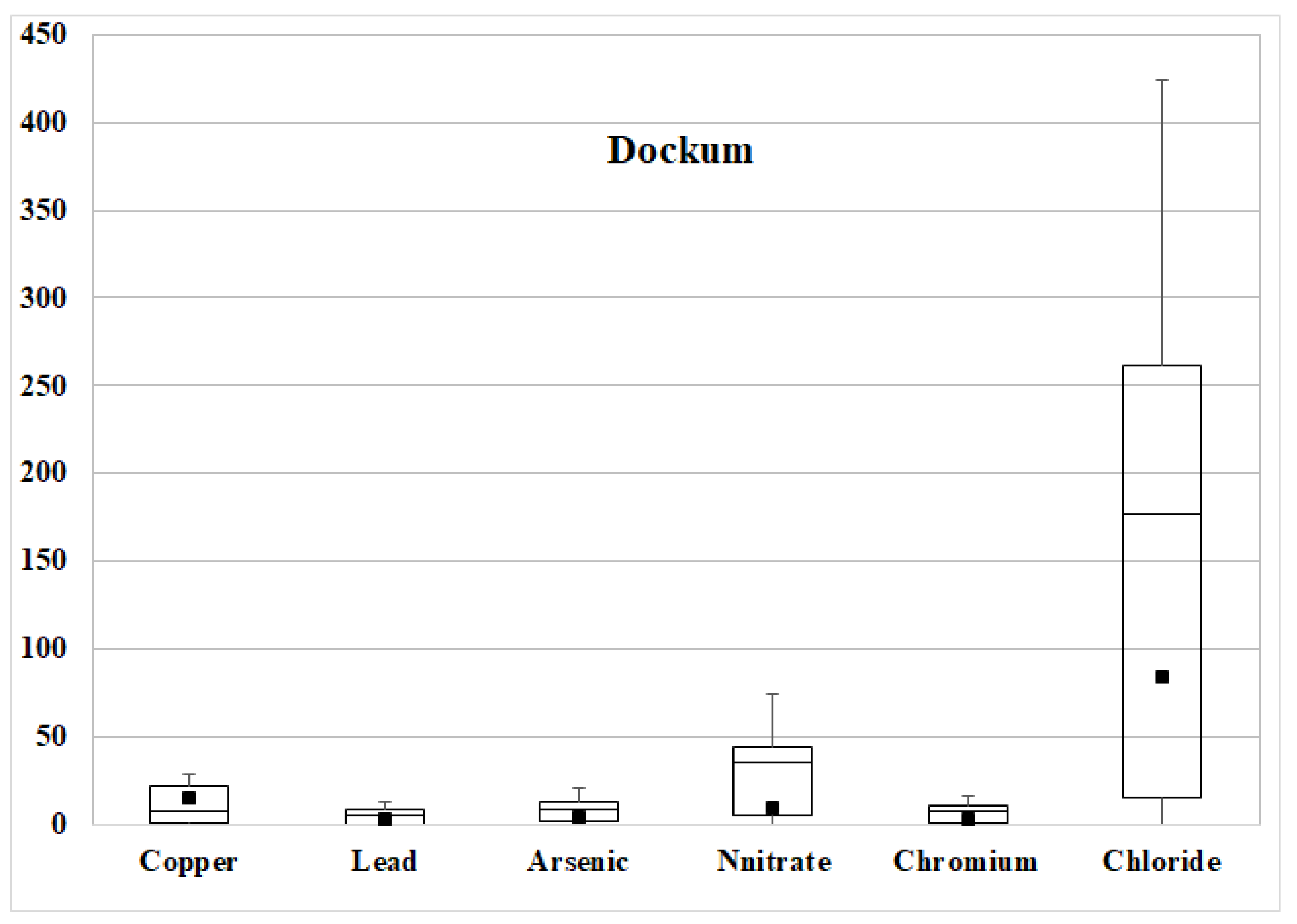
| Year | Copper (ppb) | Lead (ppb) | Arsenic (ppb) | Nitrate (ppm) | Chromium (ppb) | Chloride (ppm) | TDS (ppm) |
|---|---|---|---|---|---|---|---|
| 1987 | N/A | N/A | N/A | 1.83 | N/A | 22.00 | 302.00 |
| 1995 | 6.00 | 5.00 | 2.00 | 1.84 | 8.00 | 21.00 | 4.00 |
| 2000 | 3.04 | 1.28 | 2.53 | 4.56 | 3.23 | 28.40 | 317.00 |
| 2002 | 2.58 | 0.00 | 2.00 | 2.71 | 1.99 | 29.90 | 316.00 |
| 2007 | 1.00 | 50.00 | 1.00 | 3.80 | 1.00 | 30.00 | 326.00 |
| 2011 | 1.00 | 1.00 | 2.00 | 1.82 | 32.90 | 32.90 | 329.00 |
| 2018 | 1.00 | 1.00 | 1.00 | 1.40 | 1.00 | 36.80 | 353.76 |
| Year | Copper (ppb) | Lead (ppb) | Arsenic (ppb) | Nitrate (ppm) | Chromium (ppb) | Chloride (ppm) | TDS (ppm) |
|---|---|---|---|---|---|---|---|
| 1972 | N/A | N/A | N/A | 5.00 | N/A | 15.00 | 224.00 |
| 1985 | N/A | N/A | N/A | 5.49 | N/A | 104.00 | 513.00 |
| 1987 | N/A | N/A | N/A | 5.05 | N/A | 18.00 | 251.00 |
| 1995 | 6.00 | 5.00 | N/A | 8.30 | N/A | 37.00 | 320.00 |
| 2000 | 5.70 | 4.80 | 6.90 | 30.10 | 5.80 | 139.00 | 812.00 |
| 2004 | 1.96 | 1.00 | 2.00 | 5.84 | 0.00 | 162.00 | 656.00 |
| 2008 | 1.23 | 0.84 | N/A | 5.89 | 1.17 | 118.00 | 625.00 |
| Aquifer Name | Aquifer Type | Description | Thickness (ft) | Average pH (STD) |
|---|---|---|---|---|
| Pecos Valley | Unconfined, Alluvial | Aeolian and eolian sediments consisting with beds of clay, silt, sand, gravel, and caliche | 0~1500 (top~bottom) | 7.60 (0.41) |
| Dockum | Confined and Unconfined, Sandston | Fine grained sandstone. | 160~1300 (top~bottom) | 7.59 (0.60) |
| Minimum | Maximum | Average | STD | CV | |
|---|---|---|---|---|---|
| Copper | 0.001 | 0.006 | 0.001 | 0.002 | 1.371 |
| Lead | 1.000 | 50.000 | 9.713 | 19.812 | 2.040 |
| Arsenic | 1.000 | 2.530 | 1.755 | 0.620 | 0.353 |
| Nitrate | 1.395 | 4.560 | 2.565 | 1.191 | 0.464 |
| Chromium | 1.000 | 32.900 | 48.120 | 12.465 | 0.259 |
| Chloride | 21.000 | 36.800 | 28.714 | 5.637 | 0.196 |
| Minimum | Maximum | Average | STD | CV | |
|---|---|---|---|---|---|
| Copper | 1.230 | 6.000 | 14.890 | 0.002 | 0.000 |
| Lead | 0.084 | 5.000 | 2.911 | 2.299 | 0.790 |
| Arsenic | 2.000 | 6.900 | 4.450 | 3.465 | 0.779 |
| Nitrate | 5.000 | 30.100 | 9.380 | 9.204 | 0.981 |
| Chromium | 1.170 | 5.800 | 3.485 | 3.067 | 0.880 |
| Chloride | 15.000 | 162.000 | 84.714 | 60.536 | 0.715 |
Publisher’s Note: MDPI stays neutral with regard to jurisdictional claims in published maps and institutional affiliations. |
© 2021 by the authors. Licensee MDPI, Basel, Switzerland. This article is an open access article distributed under the terms and conditions of the Creative Commons Attribution (CC BY) license (https://creativecommons.org/licenses/by/4.0/).
Share and Cite
Lozano, J.; Heo, J.; Seo, M. Historical Assessments of Inorganic Pollutants in the Sinkhole Region of Winkler County, Texas, USA. Sustainability 2021, 13, 7513. https://doi.org/10.3390/su13137513
Lozano J, Heo J, Seo M. Historical Assessments of Inorganic Pollutants in the Sinkhole Region of Winkler County, Texas, USA. Sustainability. 2021; 13(13):7513. https://doi.org/10.3390/su13137513
Chicago/Turabian StyleLozano, Joshua, Joonghyeok Heo, and Mijin Seo. 2021. "Historical Assessments of Inorganic Pollutants in the Sinkhole Region of Winkler County, Texas, USA" Sustainability 13, no. 13: 7513. https://doi.org/10.3390/su13137513






